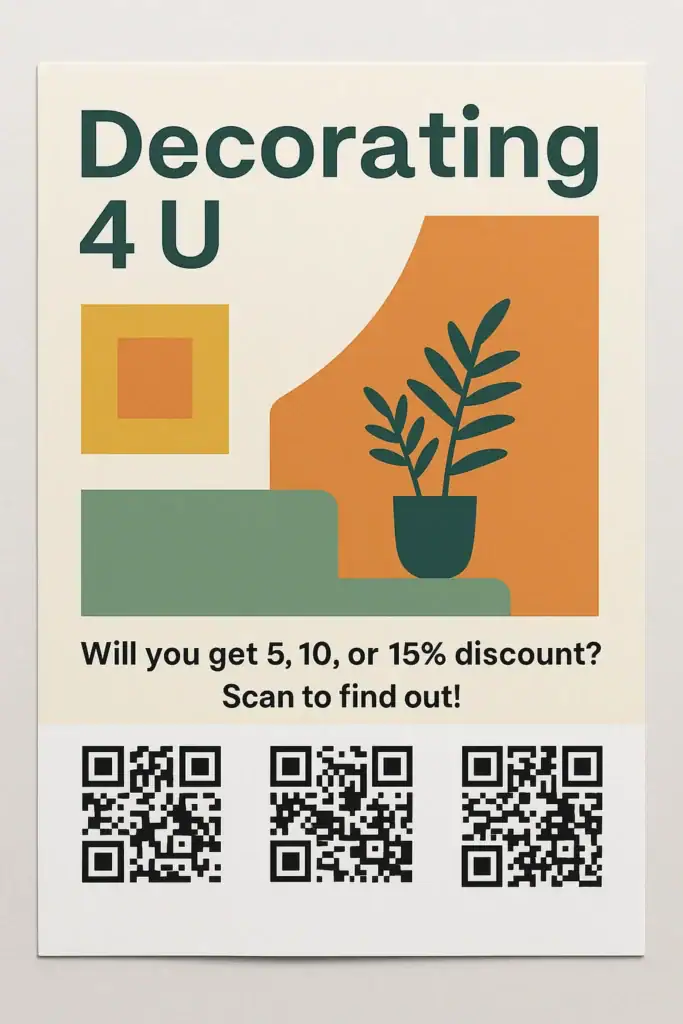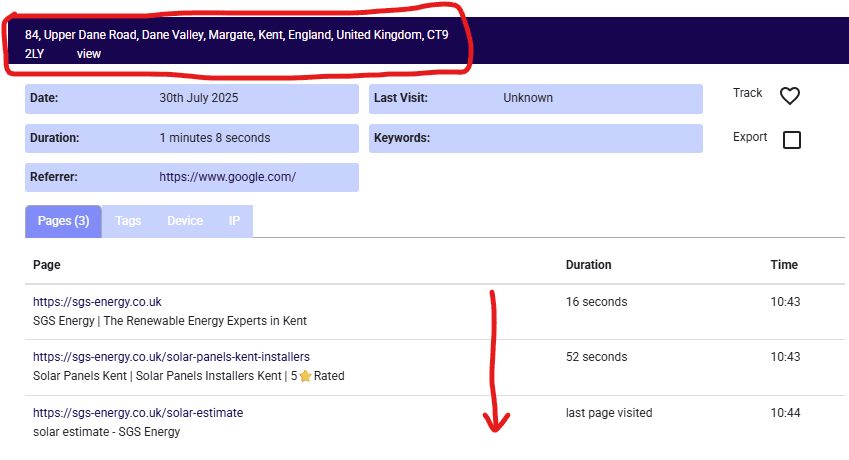Leaflet drops can still drive real results for local businesses – if they’re done properly.
For tradespeople, estate agents, windows & doors companies, private dentists, landscapers, and other businesses that sell to homeowners, dropping leaflets through letterboxes remains one of the most direct and cost-effective ways to generate leads.
But here’s the problem: too many businesses deliver thousands of leaflets without ever knowing if they worked. Someone may visit your website or give you a call, but unless they quote a specific code or follow an exact website URL link, you’ll never be sure it came from the leaflet.
In this guide, we’re going to show you a smarter way to track, follow up and ultimately get better return on investment (ROI) from your leaflet campaigns.
That includes a method you won’t have used before – using multiple QR codes and our address-identification software, so you’ll know exactly which households showed interest in your leaflet.
If you want to understand the full picture – from leaflet costs to best practices – read on.
But if you’re here more to find out how to turn flyer scans into physical addresses, you can skip ahead to our address identification strategy.
Leaflets still have power in 2025
We work in the digital space every day, so it might surprise you when we say: leaflets still work.
Why? Because they’re tangible. People remember them. When delivered to the right households with the right message, they continue to generate interest and enquiries – especially in industries where the service is local and home-focused.
Research from the Direct Marketing Association suggests that:
- 89% of people remember receiving a leaflet.
- 45% keep one for future reference.
We’ll admit that we’re sceptical those numbers are that high in practice because many flyers do go straight in the bin. But we’ve all experienced the other side too: the one leaflet that gets pinned to the fridge or kept in a drawer “just in case”.
That’s why leaflet drops are still widely used by:
- Home improvement businesses (e.g. windows, roofing, kitchens)
- Tradespeople (e.g.plumbers, electricians, painters)
- Medical and wellness providers (e.g. dentists, physiotherapists)
- Local estate agents
- Domestic services (e.g. cleaning, gardening)
- Event venues and photographers
- … and many others
If your business relies on local homeowners, leaflets give you a way to reach them directly – no algorithms, no bidding wars, just a physical presence in their home.
What leaflet drops actually cost in 2025
To make an informed decision about ROI, it helps to understand the typical cost breakdown. These haven’t changed drastically, but inflation and labour costs have nudged the numbers up in the last 12–18 months.
Design and print
Leaflet printing is usually charged per thousand. Based on 2025 prices:
- Basic single-sided A5: ~£60 per 1,000 leaflets
- Double-sided, full-colour A5: £100–£140 per 1,000 (recommended)
- Heavier stock or unusual sizes: £150–£200+ per 1,000
You can reduce costs by printing only on one side, but we don’t recommend it – you’re wasting half the space. Similarly, poor quality print or paper often leads to your leaflet being binned before it’s even read.
Tip: Use one side for your headline offer, QR codes, and action steps. Use the other side for testimonials, photos of your work, or more detailed service explanations.
Distribution methods and costs
Free or community options
- DIY / family / staff – Time-consuming but free
- Local youth groups (e.g. Scouts): £20–£40 per 1,000 leaflets as a donation.
Shared leaflet distribution companies
- Around £40–£65 per 1,000. Your leaflet is bundled with others. Lower cost but also less visible.
Royal Mail Door-to-Door
- Around £60–£85 per 1,000. Trusted, wide reach, but you lose control over the exact delivery window.
Solo distribution via leaflet specialists
- £70–£120 per 1,000. This is the premium route: your leaflet is delivered on its own, to a defined area, with reporting.
These costs add up, so getting just a 1% response rate (10 people out of 1,000) may not feel like a win – unless those 10 convert to real, high-value customers.
Why most leaflet campaigns fail to deliver ROI
There’s a fundamental issue with how most businesses approach leaflet marketing: once the flyers are posted, the tracking ends.
Some try using:
- Voucher codes
- Dedicated URLs (e.g. yoursite.com/offer)
- Unique phone numbers
These are good practices – and we’ll revisit them below – but they rely on the recipient following instructions. Many don’t. They’ll just Google your business or visit your homepage.
That means your campaign could be working – but you won’t know which leads came from which streets. You’re left guessing.
A smarter way to get more from every leaflet drop
Here’s where we bring a smarter, more measurable strategy to the table – combining offline leaflet distribution with online intelligence.
Step 1: include three QR codes on your leaflet
Add three separate QR codes to your flyer, with a message like this:
“Will you get 5, 10, or 15% discount? Scan to find out!”

Most people won’t stop at scanning one QR code. They’ll scan all three, until they find the best deal.
That’s fine – in fact, it’s the point – to make them feel that they’ve been clever to unlock the best discount.
You now have three landing pages, each linked to a different code, and each visit tells you something about the person’s interest level. For example, is someone keeps scanning until they get the maximum discount then you know they’re more interested.
Step 2: each QR code links to a unique page on your website
Each QR code goes to a different URL – such as:
- yourwebsite.com/5
- yourwebsite.com/10
- yourwebsite.com/15
These pages are easy to create, are duplicates of each other, with the only difference being the level of discount ‘won’. The purpose of the landing pages is to get the people to quote the unique reference code on that page when they get in touch with you (e.g. AUGUST15).
Step 3: identify the home addresses that scanned the codes
This is where Who Visits My Website becomes a game-changer.
When someone scans your code and visits your website, our software detects the visit and – based on multiple data sources – identifies the exact home address that the visit came from. Here’s an example:

You’re not just seeing anonymous clicks. You’re seeing:
- Which QR code they scanned
- When they scanned it
- The address of the house the visit came from
There are no forms to fill. No tracking cookies needed. And no need for the customer to take any extra steps.
You now know which homes were engaged enough in your leaflet for them to scan your QR code(s) – and can follow up accordingly.
What you can do with that data
Knowing which homes scanned your leaflet means you can:
- Send a more personalised follow-up to each address: A high-quality brochure would be best because you know they’re interested, so it’s worth the relatively low cost to put a quality brochure through their door so that they can find out more about your business and share it with other decision makers. You can find out a lot more about why quality of brochure matters here.
- Strengthen the message via a covering letter with the brochure: If they scanned the 15% discount, you can reinforce the urgency of what date they have to claim it by, and also sweeten the deal further by giving them another reference to quote to get an even higher discount (e.g. AUGUST17 to get 17% instead of 15%)
Some people don’t focus beyond the leaflet – that’s a mistake.
These are people who received your leaflet, bothered to scan your QR code(s), and may even have looked at other pages of your website (all of which can be tracked) so it makes a lot of sense to invest a little bit more to gain conversions to enquiries from many of those people.
If nothing else, it’s worth trying out for a defined number of brochure sendouts (50 would be a good test and not cost much).
Total ROI measurement
When someone sees your leaflet, scans one of your QR codes, and then makes contact, they’re directed to a specific landing page with a unique code.
If they quote that code by phone, email, or online, you’ll know exactly which part of your leaflet campaign led to the enquiry.
For those who scanned a QR code but didn’t get in touch immediately, identifying their home address allows you to follow up by post. Sending a high-quality brochure with a personalised covering letter – and including a new, trackable offer code – gives you a second chance to convert them, while maintaining full visibility over the lead source.
From leaflet to lead: a better return on your investment
The average leaflet campaign without tracking is a guessing game.
Did anyone notice the flyer? Did they visit your website? Should you send more next month – or change tack entirely?
But with a leaflet + QR + address identification setup, the guesswork disappears. You don’t just hope people respond – you know exactly which houses did.
You go from:
Scattergun marketing – Drop 5,000 leaflets and hope.
To:
Sharpshooter targeting – Follow up only with the 50 homes that engaged.
That’s the kind of marketing that gets real ROI.


